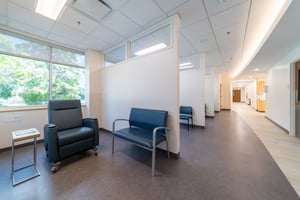Great design doesn’t have to be complicated. In fact, some of the most impactful decisions we make...
Operating Room Showdown: Total Joint vs. Vascular Access OR's
Designing ambulatory surgery center operating rooms is not a one-size-fits-all process. To optimize safety, efficiency, and outcomes, it is important to tailor OR's to the specific requirements of the primary specialty it will accommodate. Whether supporting complex orthopedic surgeries or high-volume vascular access procedures, the design should address not only space and equipment needs but also the environmental, staffing, and infection control demands unique to the specialty. Understanding these differences is key to creating high-performing outpatient surgical environments.
Total Joint Replacement ORs: Built for Complexity and Flexibility
Total joint replacement procedures require larger, more sophisticated ORs that support complex workflows, advanced equipment, and rigorous infection control.
Key Design Features:
-
Size: Typically 500 to 600 square feet to accommodate larger equipment, implants, and multiple personnel.
-
Equipment: Specialty OR tables, such as the Hana table, are common. They are larger than ordinary OR tables and require more space. Larger back tables are needed for extensive instrument trays and implant kits. In addition to typical OR equipment, these rooms may also house surgical robots or navigation systems.
-
Booms and Ceiling Height: Multi-arm booms carrying lights, monitors, and other surgical accoutrements are common. This may necessitate increased ceiling height to ensure clearance and flexibility.
-
Power Infrastructure: The rooms are usually considered wet procedure rooms where isolated power is required. Extensive electrical and IT infrastructure may also be necessary to support robotics and imaging integration.
-
HVAC Systems: More robust HVAC is important to achieve and maintain the lower room temperatures preferred by orthopedic surgeons. HEPA filtration is required for these rooms to reduce the risk of surgical site infection.
-
Imaging and Shielding: A mobile C-arm is frequently used and lead shielding is often required, depending on the extent and duration of imaging.
-
Sterile Setup Zones: A sterile instrument setup area outside the OR is ideal for prepping large trays without occupying OR space.
-
Table Orientation: A layout that allows the table to rotate within the room can accommodate different joint procedures and improve team ergonomics.
-
Anesthesia and Recovery: General or regional anesthesia is typically required, meaning rooms must accommodate anesthesia machines, gas lines, and monitoring equipment. Post-op recovery areas should support longer Phase I stays.
-
Workflow and Turnover: Total joint procedures are longer in duration and have slower turnover times, so room layout and supply access must be optimized for efficiency without compromising safety.
These design measures correspond to the unique demands of total joint replacement surgery. Their implementation will enhance safety and productivity in total joint operating rooms.

Vascular Access ORs: Purpose-Built for Simplicity and Throughput
Vascular access procedures such as port placements or dialysis fistulas are less complex and call for leaner, more compact ORs that support high case volumes and prompt turnover.
Key Design Features:
-
Size: Typically 300 to 400 square feet. The smaller footprint accommodates a streamlined team and equipment setup.
-
Equipment: Standard OR tables and fewer back tables are sufficient. Instrument trays are minimal and often preassembled or disposable. C-arms are typically used in these procedures and must be accommodated.
-
Ceiling Systems: Typically limited to a single ceiling-mounted light. Lower ceiling heights may be adequate, and other equipment booms are not typical.
-
Power Infrastructure: These procedures are not usually classified as wet procedures, so isolated power is generally not necessary. To be sure in each specific case, it is recommended to have the facility conduct a wet procedure assessment during design.
-
HVAC Systems: HVAC design is usually more straightforward and typical OR filtration sufficient. The lower ambient temperatures preferred by orthopedic surgeons are most often not required, but the doctor and staff do wear lead vests during procedures, so it is important to review the question during design.
-
Imaging and Shielding: Mobile C-arm use is routine in these procedures and lead shielding of the room is usually required. Imaging needs are more basic, and integration with other surgical systems is not common.
-
Storage: Built-in cabinetry within the room for immediate access to supplies is common and reduces dependency on adjacent sterile cores.
-
Workflow: Instrument setup is done within the room and follows a standard layout that supports quick turnover.
-
Anesthesia and Recovery: Most procedures use local anesthesia with light to moderate sedation. Anesthesia equipment needs are more minimal and recovery time is shorter.
-
Infection Control: Infection risk is lower than in more complex procedures. Surface finishes and environmental controls may be less stringent, though still must be designed to meet OR standards.
-
Staffing and Turnover: These rooms support a higher volume of cases with faster turnover. Layout should support rapid cleaning and efficient room reset between procedures.
This streamlined approach makes vascular access ORs ideal for facilities prioritizing volume, efficiency, and lower-complexity procedures.

One Size Does Not Fit All
As ASCs expand across multiple specialties, tailoring operating rooms to the specific demands of various procedure types is important. Designing around clinical needs, rather than relying on a one-size-fits-all approach, ensures that rooms support safety, efficiency, and a high standard of care.
Whether planning a high-performance suite for orthopedic robotics or a focused space for vascular access, smart design choices can enhance outcomes, reduce complications, and make better use of every square foot.
At AHD*lab, we help healthcare leaders envision operating environments that are optimized for both today’s procedures and tomorrow’s possibilities. If you’re designing a new ASC or renovating an existing one, let’s talk about how to match your spaces with your specialties.



